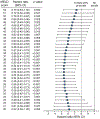Identification of optimal therapeutic window for steroid use in severe alcohol-associated hepatitis: A worldwide study
- PMID: 34166722
- PMCID: PMC11090180
- DOI: 10.1016/j.jhep.2021.06.019
Identification of optimal therapeutic window for steroid use in severe alcohol-associated hepatitis: A worldwide study
Abstract
Background & aims: Corticosteroids are the only effective therapy for severe alcohol-associated hepatitis (AH), defined by a model for end-stage liver disease (MELD) score >20. However, there are patients who may be too sick to benefit from therapy. Herein, we aimed to identify the range of MELD scores within which steroids are effective for AH.
Methods: We performed a retrospective, international multicenter cohort study across 4 continents, including 3,380 adults with a clinical and/or histological diagnosis of AH. The main outcome was mortality at 30 days. We used a discrete-time survival analysis model, and MELD cut-offs were established using the transform-the-endpoints method.
Results: In our cohort, median age was 49 (40-56) years, 76.5% were male, and 79% had underlying cirrhosis. Median MELD at admission was 24 (19-29). Survival was 88% (87-89) at 30 days, 77% (76-78) at 90 days, and 72% (72-74) at 180 days. A total of 1,225 patients received corticosteroids. In an adjusted-survival-model, corticosteroid use decreased 30-day mortality by 41% (hazard ratio [HR] 0.59; 0.47-0.74; p <0.001). Steroids only improved survival in patients with MELD scores between 21 (HR 0.61; 0.39-0.95; p = 0.027) and 51 (HR 0.72; 0.52-0.99; p = 0.041). The maximum effect of corticosteroid treatment (21-30% survival benefit) was observed with MELD scores between 25 (HR 0.58; 0.42-0.77; p <0.001) and 39 (HR 0.57; 0.41-0.79; p <0.001). No corticosteroid benefit was seen in patients with MELD >51. The type of corticosteroids used (prednisone, prednisolone, or methylprednisolone) was not associated with survival benefit (p = 0.247).
Conclusion: Corticosteroids improve 30-day survival only among patients with severe AH, especially with MELD scores between 25 and 39.
Lay summary: Alcohol-associated hepatitis is a condition where the liver is severely inflamed as a result of excess alcohol use. It is associated with high mortality and it is not clear whether the most commonly used treatments (corticosteroids) are effective, particularly in patients with very severe liver disease. In this worldwide study, the use of corticosteroids was associated with increased 30-day, but not 90- or 180-day, survival. The maximal benefit was observed in patients with an MELD score (a marker of severity of liver disease; higher scores signify worse disease) between 25-39. However, this benefit was lost in patients with the most severe liver disease (MELD score higher than 51).
Keywords: MELD; Maddrey discriminant function; alcohol; alcohol-associated liver disease; alcoholic hepatitis; alcoholic liver disease; cirrhosis; corticosteroids; steroids.
Copyright © 2021 European Association for the Study of the Liver. Published by Elsevier B.V. All rights reserved.
Conflict of interest statement
Conflict of interest The authors declare no conflicts of interest that pertain to this work. Please refer to the accompanying ICMJE disclosure forms for further details.
Figures




References
-
- World Health Organization. Global Status Report on Alcohol and Health 2018. World Health Organization; 2019.
-
- Jmelnitzky A. Alcoholic hepatitis: epidemiologic nature and severity of the clinical course in Argentina. Acta Gastroenterol Latinoam 1987;17:287–297. - PubMed
Publication types
MeSH terms
Substances
Grants and funding
LinkOut - more resources
Full Text Sources
Other Literature Sources
Medical

